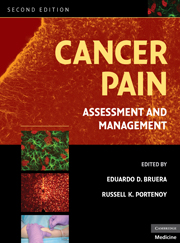Book contents
- Frontmatter
- Contents
- Contributors
- Preface
- SECTION I MECHANISMS AND EPIDEMIOLOGY
- SECTION II EPIDEMIOLOGY AND SYNDROMES
- SECTION III ASSESSMENT
- 5 The assessment of cancer pain: measurement strategy
- 6 Multidimensional assessment: pain and palliative care
- 7 Evaluating pain for children with cancer
- 8 Pain syndromes in cancer survivors
- SECTION IV PHARMACOLOGICAL TREATMENT
- SECTION V OTHER INTERVENTIONAL STRATEGIES
- SECTION VI REHABILITATION AND PSYCHOLOGICAL INTERVENTIONS
- SECTION VII THE ROLE OF ANTINEOPLASTIC THERAPIES IN PAIN CONTROL
- SECTION VIII PAIN IN SPECIAL POPULATIONS
- SECTION IX DIFFICULT PAIN PROBLEMS
- SECTION X SYSTEMS OF CARE
- Index
- Plate section
- References
7 - Evaluating pain for children with cancer
from SECTION III - ASSESSMENT
Published online by Cambridge University Press: 06 July 2010
- Frontmatter
- Contents
- Contributors
- Preface
- SECTION I MECHANISMS AND EPIDEMIOLOGY
- SECTION II EPIDEMIOLOGY AND SYNDROMES
- SECTION III ASSESSMENT
- 5 The assessment of cancer pain: measurement strategy
- 6 Multidimensional assessment: pain and palliative care
- 7 Evaluating pain for children with cancer
- 8 Pain syndromes in cancer survivors
- SECTION IV PHARMACOLOGICAL TREATMENT
- SECTION V OTHER INTERVENTIONAL STRATEGIES
- SECTION VI REHABILITATION AND PSYCHOLOGICAL INTERVENTIONS
- SECTION VII THE ROLE OF ANTINEOPLASTIC THERAPIES IN PAIN CONTROL
- SECTION VIII PAIN IN SPECIAL POPULATIONS
- SECTION IX DIFFICULT PAIN PROBLEMS
- SECTION X SYSTEMS OF CARE
- Index
- Plate section
- References
Summary
Introduction
All children with cancer undoubtedly will experience some pain during the course of their treatment. Children may experience many different types of pain from invasive procedures, the cumulative effects of toxic therapies, progressive disease, or psychological factors. The pain often is complex, with multiple sources comprising nociceptive and neuropathic components. In addition, several situational factors usually contribute to children's pain, distress, and disability. Thus, pain assessment is an integral component of diagnosis and pain management for all children with cancer. At diagnosis, we need a reliable evaluation of the sensory features of a child's pain and an understanding of the relevant psychosocial factors that can exacerbate pain and distress. Subsequent assessments of pain intensity enable us to determine when treatments are effective and to identify the children for whom they are most effective.
Pain assessment is a dynamic process that begins with a diagnostic examination and culminates with a clinical decision that a child's pain has improved sufficiently. The assessment tools or specific measures we use differ depending on our clinical objectives – to capture pertinent diagnostic information, to routinely monitor pain intensity during treatment, to document pain features and symptoms related to different types of cancer and different treatment protocols, and to assess whether psychosocial factors are exacerbating pain and distress. In this chapter, we recommend a practical approach to achieve these varied clinical objectives.
- Type
- Chapter
- Information
- Cancer PainAssessment and Management, pp. 130 - 144Publisher: Cambridge University PressPrint publication year: 2009



